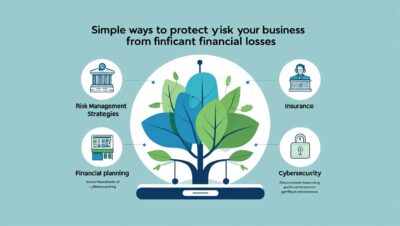✅ 1. Introduction Hook: A relatable statement about how unpredictable business can be. Introduce the idea: Losses are part of business
✅ 1. Introduction
- Hook: A relatable statement about how unpredictable business can be.
- Introduce the idea: Losses are part of business—
 but many can be prevented.
but many can be prevented. - Preview the article: “This article outlines simple, smart steps to shield your business from major losses.”
Example intro:
Running a business always involves risk—but not all risks have to lead to disaster. From cyber threats to financial mismanagement, even the smallest oversight can snowball into serious loss. The good news? You can reduce your exposure with the right strategies. In this guide, we’ll explore simple, practical ways to protect your business before small cracks become big problems.
✅ 2. Identify Common Causes of Big Business  Losses
Losses
- Poor financial management
- Lack of proper insurance
- Cybersecurity breaches
- Legal issues or regulatory violations
- Employee theft or mismanagement
- Natural disasters / market downturns
Tip: Briefly explain each one and give a real-world example (if space allows).
✅ 3. Simple Ways to Protect Your Business (Main Section, )
(Main Section, )
🔹 1. Set Up a Strong Financial System
- Use accounting software (like QuickBooks or Xero).
- Monitor cash flow weekly.
- Keep emergency savings (3–6 months of expenses).
- Work with a professional accountant.
🔹 2. Invest in Business Insurance
- Types: General liability, property, cyber, and business interruption insurance.
- Don’t go for the cheapest—match coverage to your actual risks.
🔹 3. Secure Your Digital Assets
- Use antivirus and firewall protection.
- Train staff on phishing and password safety.
- Back up data regularly (cloud and offline).
🔹 4. Create a Risk Management Plan
- Identify potential threats.
- Make a “what if” plan (response strategy for each risk).
- Review and update every 6–12 months.
🔹 5. Diversify Your Revenue Streams
- Don’t depend on a single client, vendor, or product.
- Explore passive income sources, online sales, or service add-ons.
🔹 6. Legal Protection
- Use clear contracts for all agreements.
- Stay compliant with taxes, employment law, and regulations.
- Hire a legal advisor for regular reviews.
🔹 7. Train and Monitor Your Team
- Regular staff training on safety, ethics, and role-specific skills.
- Set up checks-and-balances (e.g., no single person controls all money).
✅ 4. Case Studies or Examples  (Optional, )
(Optional, )
Share short success/failure stories:
- A small business saved from closure due to solid planning.
- A business that failed due to skipping one key strategy (like lack of backup or insurance).
✅ 5. Conclusion
- Recap: Protecting your business doesn’t require expensive systems—just smart, consistent action.
- Encourage action: “Start with one or two of these tips today, and you’ll be building long-term protection.”
✅ 6. FAQ Section (Optional)
Q1: What type of insurance is best for a small business?
A: It depends on your industry. Most businesses need general liability and property insurance at a minimum.
Q2: How often should I update my risk management plan?
A: Ideally every 6 months or after a major business change.
Q3: Is it worth hiring a financial advisor or lawyer for a small business?
A: Yes, even a short consultation can prevent costly mistakes.
🔍 SEO & Keywords Suggestions
Use these keywords naturally in the article:
- business loss prevention
- small business protection
- protect company assets
- business disaster plan
- cybersecurity for small businesses
Would you like me to generate the full 2,000-word article based on this outline?



COMMENTS